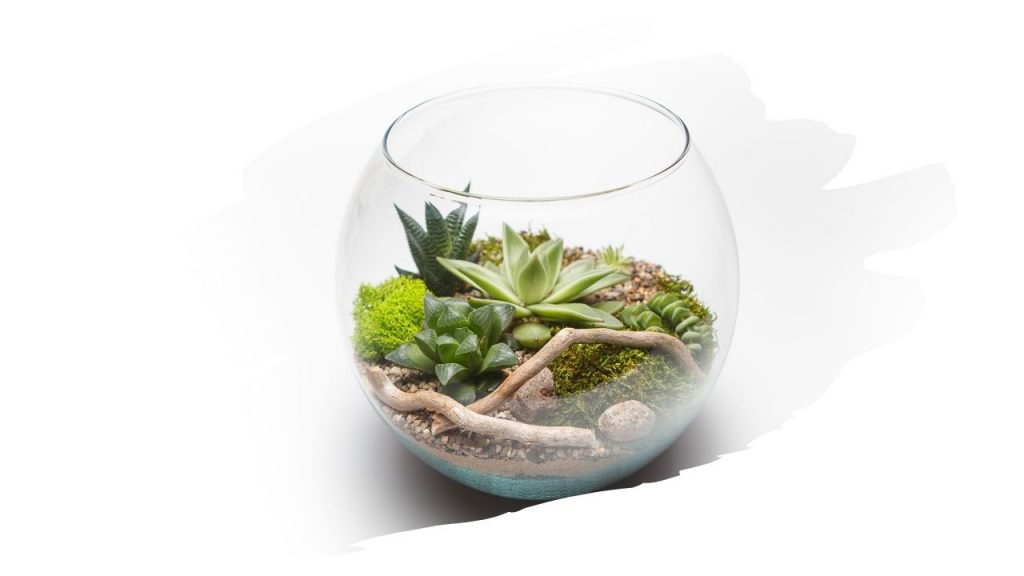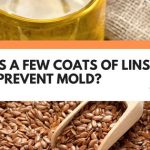Wood, when properly finished and sealed, should be water-proof enough to stop mold in its tracks.
And there are even some types of lumber, such as pressure-treated wood, that are less susceptible to mold (thanks to an infusion of mildew-resistant chemicals).
But if moisture still manages to worm its way into timber, it can become an unsightly problem.
So how does mold even manage to grow on those terrarium wood pieces?
When a terrarium wood structure becomes moldy, it’s because the wood itself is damp. That dampness is caused when moisture and condensation builds up. When this happens you will need to clean the wood, and repair the moisture imbalance inside the terrarium.
Mold rarely harms wood in and of itself. So if you give that lumber a thorough clean, you can easily fix that fungi. So keep reading to find out how…

This post may contain affiliate links to products that we receive a commission for (at no additional cost to you). Learn more here.
What’s With All That White Fuzzy Mold In Your Terrarium?
When a fungus begins to grow inside your terrarium, it will generally appear more like white fluffy webs.
This white mold, (sometimes referred to as mildew), can grow in any area of the terrarium. However, it shouldn’t cause harm to healthy plant-life.
Now, when we refer to mold that grows on wood, we are describing a type of fungi that appears in patches of greenish-brown and/or black spots. This type of mold can feel slimy to the touch, and gives off a musty scent.
Is Mold Really Such A Bad Thing In A Terrarium?
Thankfully, if your plants are fighting fit, a bit of white mold is more of an irritating inconvenience than a plant plague.
And so too with mold growth on wood. Mold doesn’t cause major structural wood damage. However, if mold starts to grow on wood, then that is a clear indication of a high-humidity environment inside that terrarium.
If timber is over-exposed to moisture, (for a prolonged length of time), it can cause wood to rot and decay. In other words, moldy wood isn’t a problem… but those high moisture levels definitely are.
So, Can Mold Even Damage Wood?
Mold doesn’t damage wood, but the spores mold releases can harm people with allergies.
Those tiny spores get released into the air wherever mold grows and thrives. And if you inhale enough of them, they can cause allergic reactions and even asthma attacks.
But let’s forget about the mold itself for a moment and start worrying about what caused it. Wood and moisture don’t go together, so if you see mold on wood, that means water has somehow seeped in.
Wood has the tendency to act like a sponge when it comes to water – it absorbs humidity, dampness, and any moisture present in the air. This is especially true if you have wood near water sources such as kitchen sinks or bathrooms.
When moisture seeps into wood, it’s like an invitation for mold and bacteria to come party. And that kind of unchecked growth can be extremely destructive.
Can Moldy Wood Be Saved?
Yes, absolutely! You can save moldy wood by removing it and cleaning it. A few simple steps can get that wood cleaned up and back to looking great again.
- REMOVE THE WOOD
Remove any wood in the terrarium that has any developing mold on it.
You’re going to need to run a careful eye (and finger) over all of the wood in the structure. And you will need to use 3 out of 5 of your senses;
- Touch: Feel for any areas that are damp and/or soft. Also search for any wood patches that leave behind a smear when you run your finger over it.
- Smell: Seek out sections that have a particularly pungent smell of rot.
- Sight: Look for any spots that have turned a greenish-brown or a dark grey-ish brown.
- REMOVE THE MOLD
Now comes the fun(gi) part. Using a filler scraper, (like the ones you use to fill in wood grain), scrape off the mold.
Do this carefully. You want to get rid of mold without scratching up the surface of the wood.
Carefully dispose of the mold scrapings. Throwing them into the garbage disposal is a No-No.
Instead, seal the scrapings up into a zip tie plastic bag and put them directly into an outdoor trash can.
- SOAK THE WOOD IN DISINFECTANT
For this step you will need to create a disinfecting solution made up of 1 part household bleach or dishwashing soap, and 4 parts warm water.
Let the wood soak in the solution for 15 to 20 minutes, and then remove it. After which, you will need to grab a cleaning sponge and scrub away any residual mold from the wood.
After that’s done, you can give the wood another rinse off in the solution.
- LET IT DRY
Lay the wood out to dry in an area where the temperature is around 77 degrees Fahrenheit (25 degrees Celsius).
You need to let the wood fully and thoroughly dry, (for up to 72 hours), before you can return it to the terrarium.
- RETURN THE WOOD TO THE TERRARIUM
Before you take this final step, make sure the wood you are returning is wholly dry.
Sure, that household bleach will get rid of that old mold. However, if you put damp wood back into the terrarium, you will only create a setting where mold can quickly grow back.
The closed-off space inside a terrarium can trap moisture in, giving fungi and bacteria the ideal place to thrive. This can quickly lead to rot and decay.
Without air circulation to help dry out the wood, it rots really quickly in these kinds of damp environments. Take any piece of damp wood and seal it in an airtight glass box, and you’ll quickly see what I mean.
In fact, did you know that untreated wood can break down after just twelve months in a terrarium? The time-line varies according to the type of wood – especially with regard to rot-resistant lumber. Nevertheless, few natural wood species are one hundred percent resistant to that kind of environment.
How Do You Keep A Terrarium From Getting Moldy?
Okay, so we’ve solved the mold growth problem in the short term. But, how do we stop mold from coming back again?
Well, mold happily thrives whenever it is near stale water. So, to prevent future problems, air out your terrarium regularly.
Set a date in your calender reminding you to remove the terrarium lid once every 30 days. And then let the terrarium air out for 2-3 days before replacing the lid.
Still, it is worth noting that condensation is a natural side-effect of healthy plants. So, regular cleaning and mold removal may simply be part and parcel of the fun of having a terrarium.
Final Thoughts
If greenish-brown or black mold appears to be growing on the wood in your terrarium, then this problem can be easily fixed;
- If mold on wood is causing an unsightly problem with your terrarium, then simply remove the wood and clean it.
- Clean the wood with a watered-down bleach solution of 1 part household bleach and 4 parts water.
- Give the wood time to dry thoroughly. And then return it to the terrarium.
References
https://terrariumtribe.com/terrarium-mould/
https://www.fpl.fs.fed.us/documnts/techline/mold-mildew-on-wood–causes-and-treatments.pdf


